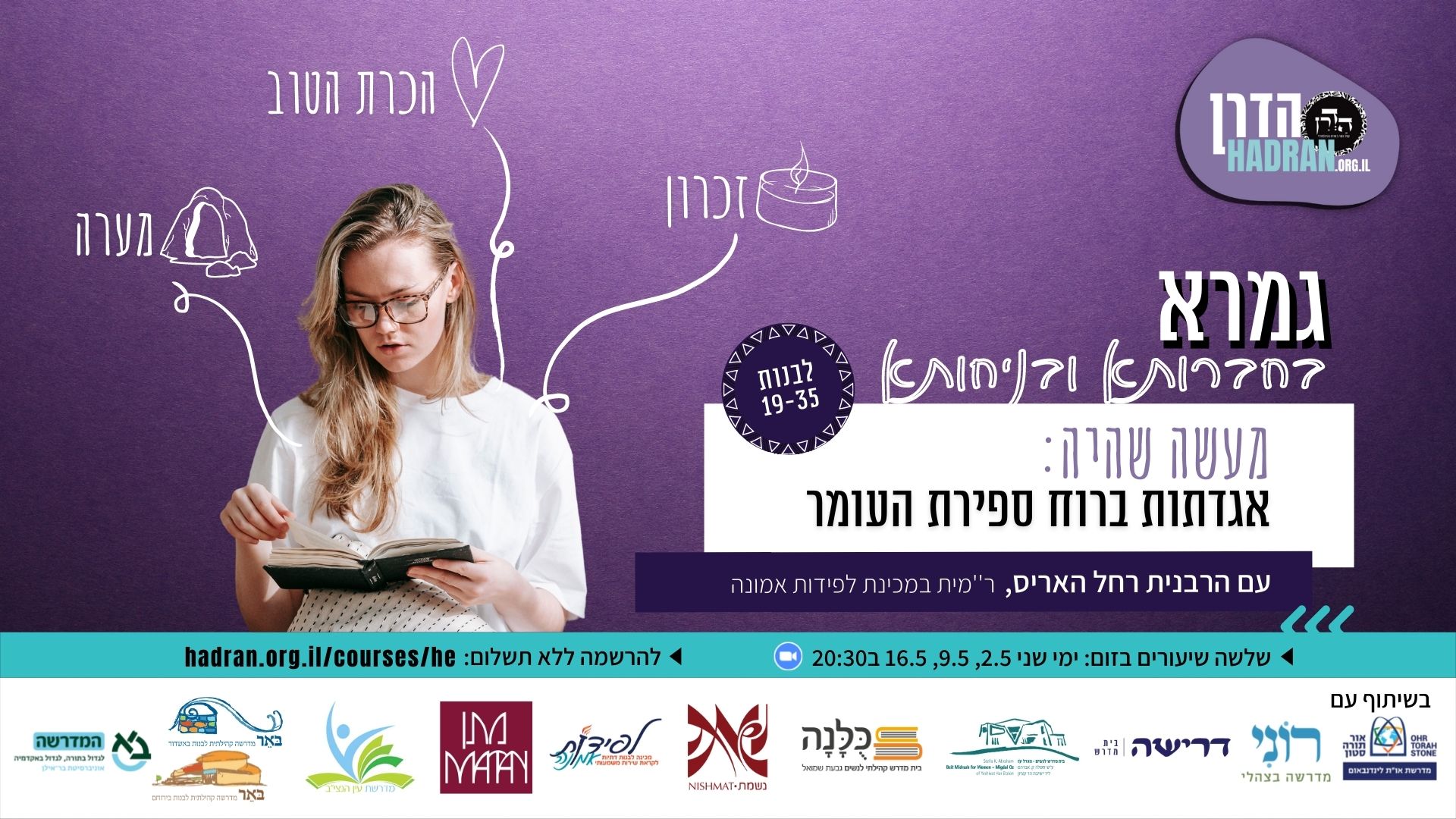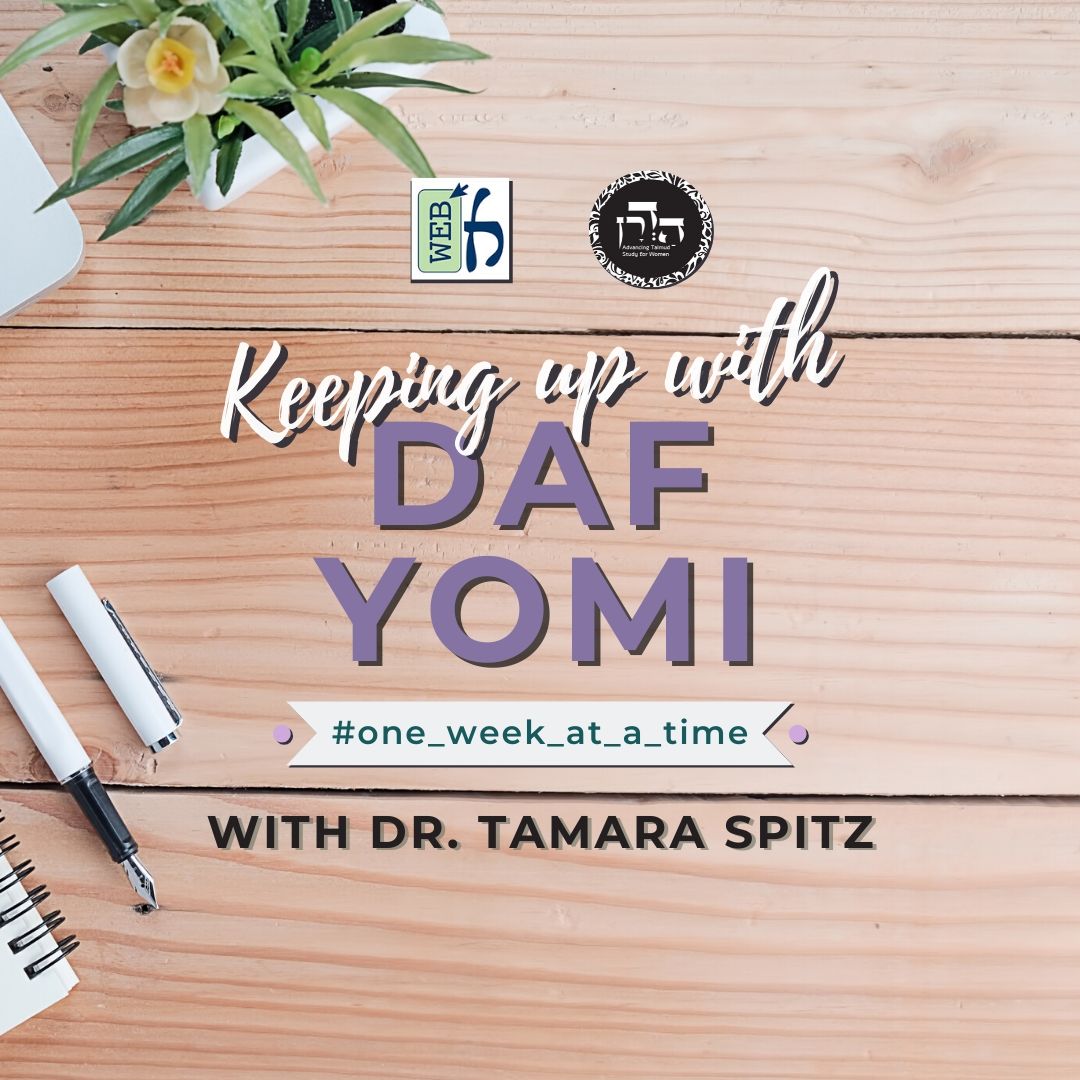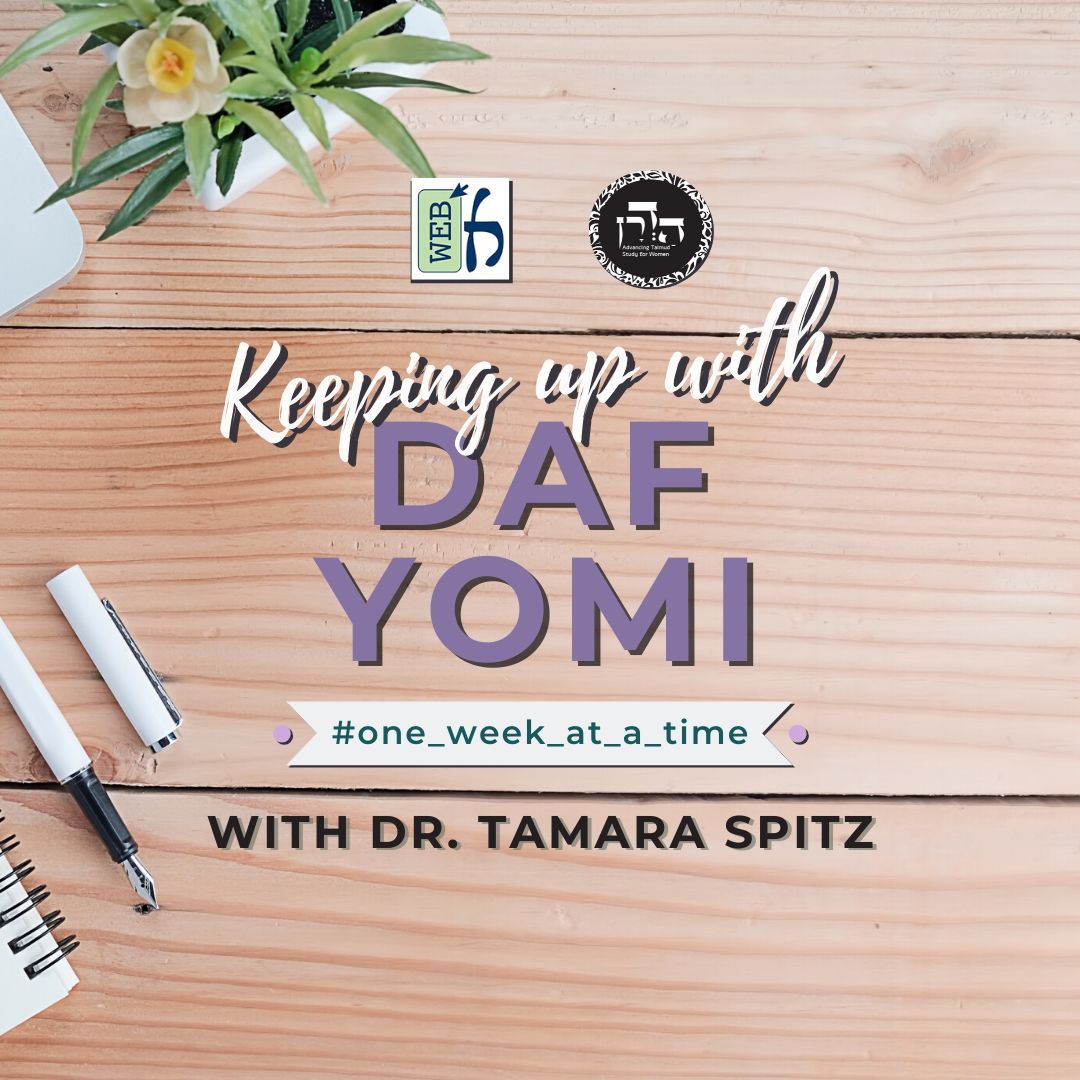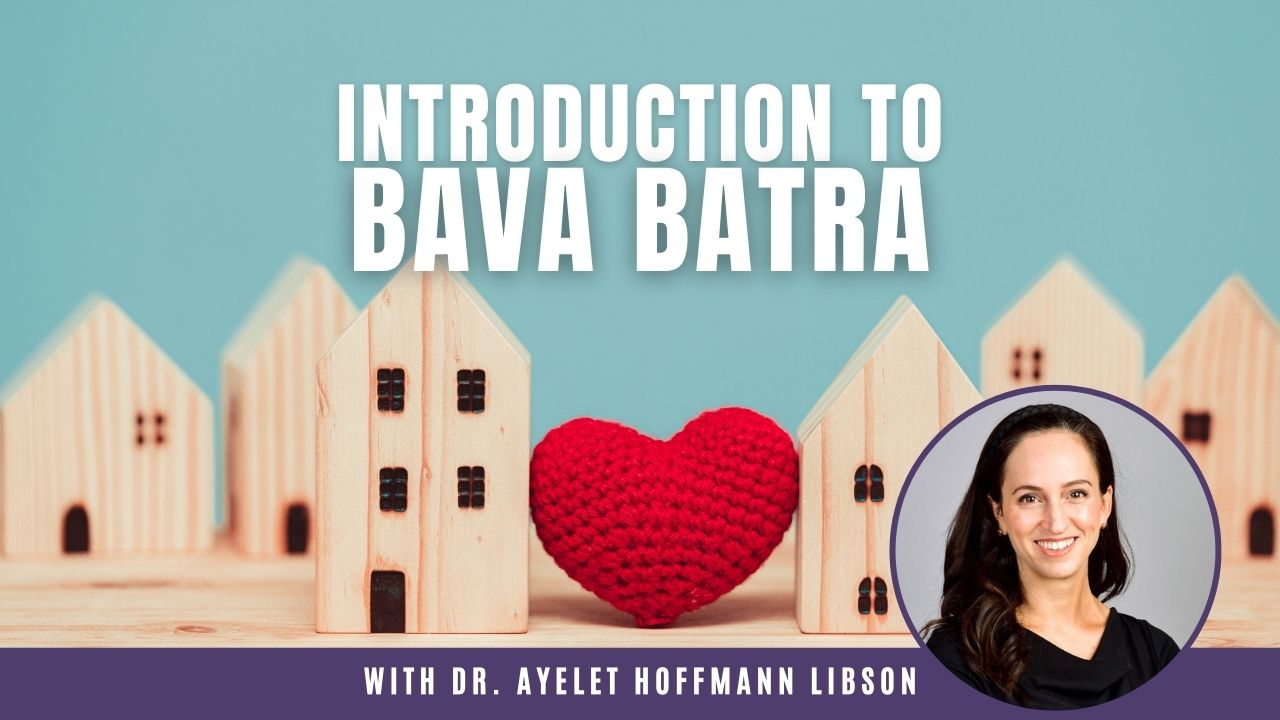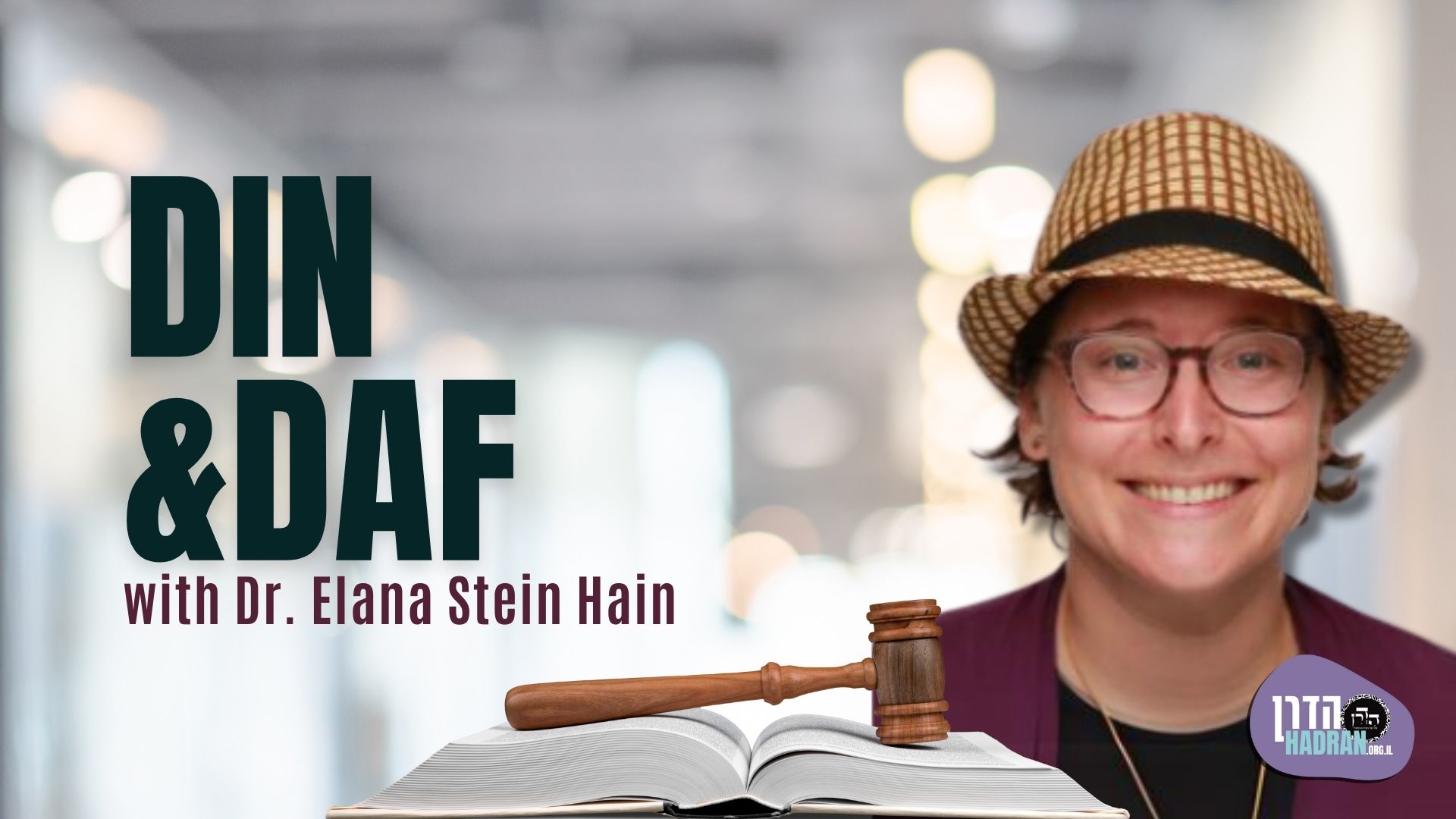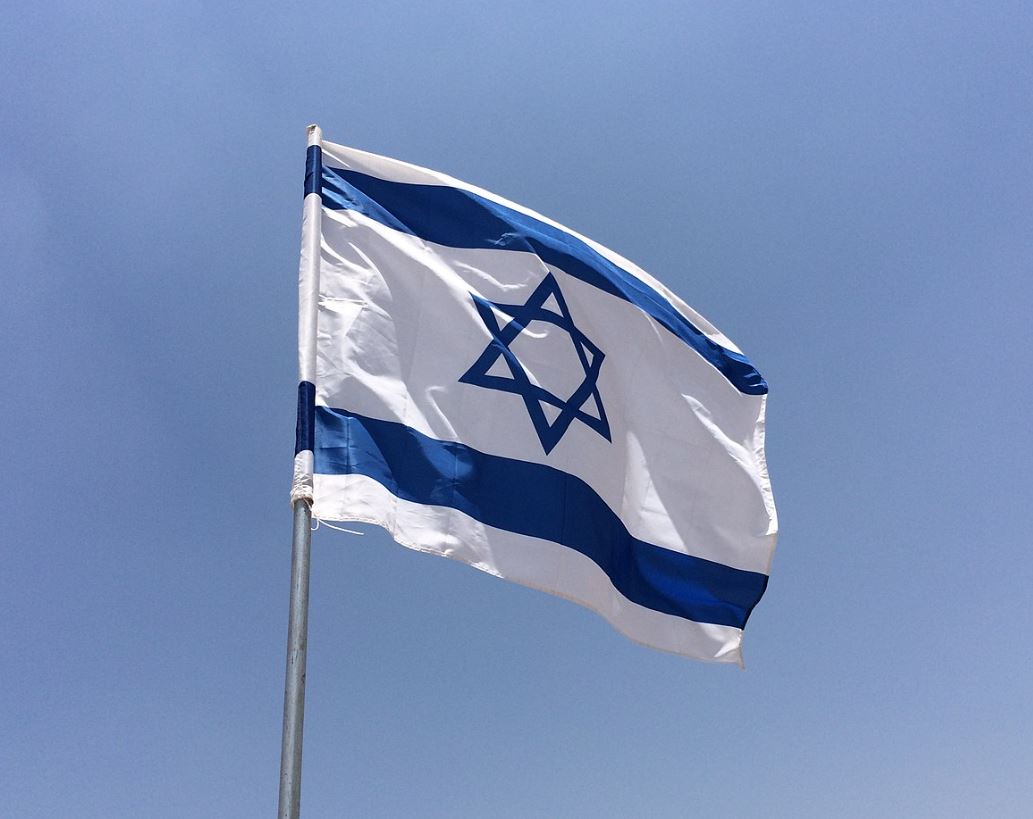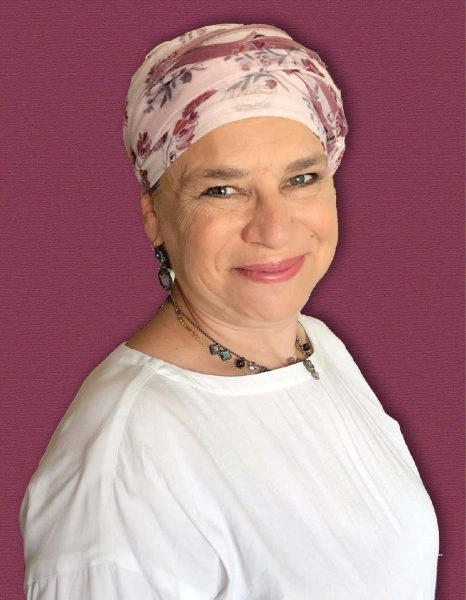What is the story of the students of Rabbi Yishmael who cooked up a prostitute doing in the middle of the chapter regarding priests who are blemished? There is a list of cases that if found in an animal would not be able to be sacrificed but in a priest, he can still work in the temple. If a priest kills someone, is he allowed to work in the temple? The mishna brings a list of cases where one could be a firstborn for either requiring redemption (pidyon haben) or for receiving a double potion of the inheritance but not for the other.
This week’s learning is sponsored by Robert and Paula Cohen in loving memory of Joseph Cohen, Yosef ben Moshe HaCohen, z”l. “He was hard working, loved to sing, esp. as a chazan, and was very dedicated to his family and community.”
Want to dedicate learning? Get started here:


Today’s daily daf tools:
This week’s learning is sponsored by Robert and Paula Cohen in loving memory of Joseph Cohen, Yosef ben Moshe HaCohen, z”l. “He was hard working, loved to sing, esp. as a chazan, and was very dedicated to his family and community.”
Today’s daily daf tools:
Delve Deeper
Broaden your understanding of the topics on this daf with classes and podcasts from top women Talmud scholars.
New to Talmud?
Check out our resources designed to help you navigate a page of Talmud – and study at the pace, level and style that fits you.
The Hadran Women’s Tapestry
Meet the diverse women learning Gemara at Hadran and hear their stories.
Bekhorot 46
לֵיהּ אַדַּעַת רַבִּים.
to the priest based on the consent of the public, making it a type of vow that cannot be dissolved without their consent.
אָמַר אַמֵּימָר: הִלְכְתָא, אֲפִילּוּ לְמַאן דְּאָמַר נֶדֶר שֶׁהוּדַּר בָּרַבִּים יֵשׁ לוֹ הֲפָרָה, עַל דַּעַת הָרַבִּים אֵין לוֹ הֲפָרָה. וְהָנֵי מִילֵּי לִדְבַר הָרְשׁוּת, אֲבָל לִדְבַר מִצְוָה יֵשׁ לוֹ הֲפָרָה. כִּי הָהוּא דְּמַקְרֵי דַרְדְּקֵי, אַדְּרֵיהּ רַב אַחָא דְּקָא פָשַׁע בְּיָנוֹקֵי, וְאַהְדְּרֵיהּ רָבִינָא, דְּלָא אַשְׁכַּח דַּהֲוָה דָּיֵיק כְּוָותֵיהּ.
Ameimar says: The halakha is as follows: Even according to the one who says a vow that was taken in public has the option of nullification, if it was taken based on the consent of the public it has no option of nullification. The Gemara comments: And this matter applies only to when the nullification of a vow is in order to enable one to perform an optional matter, but to enable one to perform a matter of a mitzva it has the option of nullification. As in the incident involving a certain teacher of children,upon whom Rav Aḥa administered a vow to cease teaching based on the consent of the public, as he was negligent with regard to the children by hitting them too much; and Ravina had his vow nullified and reinstated him, as they did not find another teacher who was as meticulous as he was.
וְהַמִּטַּמֵּא לְמֵתִים כּוּ׳. מַאי שְׁנָא הָכָא דְּסַגִּי לֵיהּ בְּקַבָּלָה, וּמַאי שְׁנָא הָתָם דְּמַדְּרִינַן לֵיהּ? הָתָם יִצְרוֹ תְּקָפוֹ.
§ The mishna teaches that a priest who becomes impure through exposure to corpses is disqualified from performing the Temple service until he accepts upon himself that he will no longer become impure in that manner. The Gemara asks: What is different here that it is sufficient for him merely to accept upon himself a commitment in order to continue serving in the Temple, and what is different there, where the priest marries by a transgression, that we administer a vow to him? The Gemara responds: There his desire seizes him, and it is therefore necessary for the priest to take a vow.
הֲדַרַן עֲלָךְ מוּמִין אֵלּוּ.
מַתְנִי׳ יֵשׁ בְּכוֹר לַנַּחֲלָה, וְאֵינוֹ בְּכוֹר לַכֹּהֵן; בְּכוֹר לִכְהֵן, וְאֵינוֹ בְּכוֹר לַנַּחֲלָה; בְּכוֹר לַנַּחֲלָה וְלַכֹּהֵן, וְיֵשׁ שֶׁאֵינוֹ בְּכוֹר לֹא לַנַּחֲלָה וְלֹא לַכֹּהֵן.
MISHNA: There is a son who is a firstborn with regard to inheritance but is not a firstborn with regard to the requirement of redemption from a priest. There is another who is a firstborn with regard to redemption from a priest but is not a firstborn with regard to inheritance. There is another who is a firstborn with regard to inheritance and with regard to redemption from a priest. And there is another who is not a firstborn at all, neither with regard to inheritance nor with regard to redemption from a priest.
אֵיזֶהוּ בְּכוֹר לַנַּחֲלָה וְאֵינוֹ בְּכוֹר לַכֹּהֵן? הַבָּא אַחַר נְפָלִים, אַף עַל פִּי שֶׁיָּצָא אֶת רֹאשׁוֹ חַי, וּבֶן תִּשְׁעָה שֶׁיָּצָא רֹאשׁוֹ מֵת, הַמַּפֶּלֶת כְּמִין בְּהֵמָה חַיָּה וָעוֹף — דִּבְרֵי רַבִּי מֵאִיר.
Which is the son who is a firstborn with regard to inheritance but is not a firstborn with regard to redemption from a priest? It is a son who came after miscarriage of an underdeveloped fetus, even where the head of the underdeveloped fetus emerged alive; or after a fully developed nine-month-old fetus whose head emerged dead. The same applies to a son born to a woman who had previously miscarried a fetus that had the appearance of a type of domesticated animal, undomesticated animal, or bird, as that is considered the opening of the womb. This is the statement of Rabbi Meir.
וַחֲכָמִים אוֹמְרִים: עַד שֶׁיְּהֵא בּוֹ מִצּוּרַת אָדָם. הַמַּפֶּלֶת סַנְדָּל, אוֹ שִׁלְיָא, אוֹ שַׁפִּיר מְרוּקָּם, וְהַיּוֹצֵא מְחוּתָּךְ — הַבָּא אַחֲרֵיהֶם בְּכוֹר לַנַּחֲלָה, וְאֵין בְּכוֹר לַכֹּהֵן.
And the Rabbis say: The son is not exempted from the requirement of redemption from a priest unless his birth follows the birth of an animal that takes the form of a person. In the case of a woman who miscarries a fetus in the form of a sandal fish or from whom an afterbirth or a gestational sac in which tissue developed emerged, or who delivered a fetus that emerged in pieces, the son who follows these is a firstborn with regard to inheritance but is not a firstborn with regard to redemption from a priest.
מִי שֶׁלֹּא הָיוּ לוֹ בָּנִים, וְנָשָׂא אִשָּׁה שֶׁכְּבָר יָלְדָה, עוֹדָהּ שִׁפְחָה וְנִשְׁתַּחְרְרָה, עוֹדָהּ נׇכְרִית וְנִתְגַּיְּירָה, מִשֶּׁבָּאת לְיִשְׂרָאֵל יָלְדָה — בְּכוֹר לַנַּחֲלָה וְאֵין בְּכוֹר לַכֹּהֵן.
In the case of a son born to one who did not have sons and he married a woman who had already given birth; or if he married a woman who gave birth when she was still a Canaanite maidservant and she was then emancipated; or one who gave birth when she was still a gentile and she then converted, and when the maidservant or the gentile came to join the Jewish people she gave birth to a male, that son is a firstborn with regard to inheritance but is not a firstborn with regard to redemption from a priest.
רַבִּי יוֹסֵי הַגְּלִילִי אוֹמֵר: בְּכוֹר לַנַּחֲלָה וְלַכֹּהֵן, שֶׁנֶּאֱמַר: ״פֶּטֶר רֶחֶם בְּיִשְׂרָאֵל״ — עַד שֶׁיִּפְטְרוּ רֶחֶם מִיִּשְׂרָאֵל.
Rabbi Yosei HaGelili says: That son is a firstborn with regard to inheritance and with regard to redemption from a priest, as it is stated: “Whatever opens the womb among the children of Israel” (Exodus 13:2). This indicates that the halakhic status of a child born to the mother is not that of one who opens the womb unless it opens the womb of a woman from the Jewish people.
מִי שֶׁהָיוּ לוֹ בָּנִים וְנָשָׂא אִשָּׁה שֶׁלֹּא יָלְדָה, נִתְגַּיְּירָה מְעוּבֶּרֶת, נִשְׁתַּחְרְרָה מְעוּבֶּרֶת.
In the case of one who had sons and married a woman who had not given birth; or if he married a woman who converted while she was pregnant, or a Canaanite maidservant who was emancipated while she was pregnant and she gave birth to a son, he is a firstborn with regard to redemption from a priest, as he opened his mother’s womb, but he is not a firstborn with regard to inheritance, because he is not the firstborn of his father or because halakhically he has no father.
וְיָלְדָה הִיא וְכֹהֶנֶת הִיא, וּלְוִיָּה הִיא, וְאִשָּׁה שֶׁכְּבָר יָלְדָה, וְכֵן מִי שֶׁלֹּא שָׁהֲתָה לְאַחַר בַּעְלָהּ שְׁלֹשָׁה חֳדָשִׁים וְנִשֵּׂאת וְיָלְדָה, וְאֵינוֹ יָדוּעַ אִם בֶּן תִּשְׁעָה לָרִאשׁוֹן אִם בִּן שִׁבְעָה לָאַחֲרוֹן — בְּכוֹר לַכֹּהֵן וְאֵינוֹ בְּכוֹר לַנַּחֲלָה.
And likewise, if an Israelite woman and the daughter or wife of a priest, neither of whom had given birth yet, or an Israelite woman and the daughter or wife of a Levite, or an Israelite woman and a woman who had already given birth, all women whose sons do not require redemption from the priest, gave birth in the same place and it is uncertain which son was born to which mother; and likewise a woman who did not wait three months after the death of her husband and she married and gave birth, and it is unknown whether the child was born after a pregnancy of nine months and is the son of the first husband, or whether he was born after a pregnancy of seven months and is the son of the latter husband, in all these cases the child is a firstborn with regard to redemption from a priest but is not a firstborn with regard to inheritance. Due to the uncertainty, he is unable to prove he is the firstborn of either father, and therefore he is not entitled to the double portion of the firstborn.
גְּמָ׳ אָמַר שְׁמוּאֵל: אֵין הָרֹאשׁ פּוֹטֵר בִּנְפָלִים.
GEMARA: Shmuel says: In a case where the head of a fetus emerged and then went back into the womb, the offspring is not considered to have been born and does not exempt the next fetus from the obligation of redemption of the firstborn, e.g., if its twin brother was born first. Shmuel says this halakha specifically in a case of miscarriage, i.e., where the fetus whose head emerged was a stillborn and the one that was eventually born first is a viable offspring. But in a case where both are viable offspring, the emergence of the head is considered birth.
מַאי טַעְמָא? ״כֹּל אֲשֶׁר נִשְׁמַת רוּחַ חַיִּים בְּאַפָּיו״ — כֹּל הֵיכָא דְּנִשְׁמַת רוּחַ חַיִּים בְּאַפָּיו הוּא דַּחֲשִׁיב רֵישֵׁיהּ, אִידַּךְ לָא חֲשִׁיב רֵישֵׁיהּ.
The Gemara asks: What is the reason for Shmuel’s ruling? The verse states: “All in whose nostrils was the breath of the spirit of life” (Genesis 7:22), from which it is derived: Anywhere that one has the breath of the spirit of life, i.e., if it is viable, one goes by its nostrils, i.e., its head is considered significant. But with regard to another offspring, one that is not viable, its head is not considered significant.
תְּנַן: הַבָּא אַחַר נְפָלִים, שֶׁיָּצָא רֹאשׁוֹ חַי, וּבֶן תִּשְׁעָה שֶׁיָּצָא רֹאשׁוֹ מֵת. קָתָנֵי מִיהָא ״רֹאשׁוֹ!״ מַאי ״רֹאשׁוֹ?״ רוּבּוֹ.
The Gemara raises a difficulty: We learned in the mishna: What is a firstborn with regard to inheritance but not with regard to redemption from a priest? It is a son who came after the miscarriage of an underdeveloped fetus, even where the head of the underdeveloped fetus emerged alive; and a fully developed nine-month-old fetus whose head emerged dead. Although the mishna addresses a nine-month-old fetus as well, in any event it teaches with regard to a miscarriage that its head exempts the offspring born after it. The Gemara responds: What is the meaning of the term: Its head? It means its head and most of the body.
וְלִיתְנֵי ״רוּבּוֹ״! בְּדִין הוּא דְּאִיבְּעִי לֵיהּ לְמִיתְנֵי רוּבּוֹ, וְאַיְּידֵי דְּקָא בָעֵי לְמִיתְנֵי סֵיפָא בֶּן תִּשְׁעָה שֶׁיָּצָא רֹאשׁוֹ מֵת — טַעְמָא דְּרֹאשׁוֹ מֵת, הָא רֹאשׁוֹ חַי — הַבָּא אַחֲרָיו בְּכוֹר לַנַּחֲלָה נָמֵי לָא הָוֵי, תְּנָא רֵישָׁא נָמֵי רֹאשׁוֹ.
The Gemara asks: But if so, let the mishna teach: Most of it. The Gemara answers: By right, the mishna should have taught: Most of it, but it did not do so, since in the latter clause of the mishna it needs to teach: A fully developed nine-month-old fetus whose head emerged dead. It is inferred from there that the reason the subsequent son is the firstborn with regard to inheritance is that the head of this fetus emerged dead, but if it was a nine–month–old fetus whose head emerged alive, then the fetus that comes after it is not a firstborn with regard to inheritance either. Therefore, the tanna of the mishna taught in the first clause also that the head of a miscarriage exempts the subsequent son, to maintain stylistic uniformity.
וּמַאי קָא מַשְׁמַע לַן, דְּכֵיוָן דְּמַפֵּיק לֵיהּ רֵישֵׁיהּ הָוֵה [לֵיהּ] לֵידָה? תְּנֵינָא: הוֹצִיא רֹאשׁוֹ, אַף עַל פִּי שֶׁהֶחְזִירוֹ — הֲרֵי זֶה כְּיָלוּד!
The Gemara asks: And according to this interpretation, what is the mishna teaching us? Is it that once the offspring reached out its head from the womb it is considered a birth? We learn this in a mishna with regard to the fetus of an animal (Ḥullin 68a): If a fetus reached out its head, although it returned the head, the halakhic status of that fetus is like that of a newborn, whose consumption is permitted only by its own slaughter.
וְכִי תֵּימָא: אַשְׁמוֹעִינַן בְּהֵמָה, וְקָא מַשְׁמַע לַן בְּאָדָם, דְּאָדָם מִבְּהֵמָה לָא יָלֵיף — דְּלֵית לַהּ פְּרוֹזְדוֹר.
And if you would say that the mishna there teaches us this halakha with regard to animals, and the mishna here teaches us that the same halakha applies to a human, this does not resolve the difficulty. The Gemara first explains why two rulings might be necessary with regard to people and animals: The reason is that the halakha of a human cannot be derived from that of an animal, as the animal has no concealed opening, i.e., the opening of an animal’s womb is not hidden. Consequently, one might have thought that only in the case of an animal is the emergence of the head considered a birth. By contrast, in humans, where the woman’s thighs conceal the opening of the womb and the emergence of the head alone is not noticeable, perhaps the emergence of the head is not considered a full-fledged birth.
בְּהֵמָה מֵאָדָם לָא יָלְפָא — מִשּׁוּם דַּחֲשִׁיב פַּרְצוּף פָּנִים דִּידֵיהּ.
Conversely, had this ruling been taught only with regard to humans, one would have said that the halakha of animals cannot be derived from that of a human because the countenance of a person’s face is significant, as people are created in the image of God. This is not so with regard to animals.
הָא נָמֵי תְּנֵינָא: יָצָא כְּדַרְכּוֹ — מִשֶּׁיָּצָא רוֹב רֹאשׁוֹ, וְאֵיזֶהוּ רוֹב רֹאשׁוֹ? מִשֶּׁתֵּצֵא פַּדַּחְתּוֹ. תְּיוּבְתָּא דִשְׁמוּאֵל, תְּיוּבְתָּא!
After clarifying why both rulings are necessary, the Gemara explains why this does not resolve the difficulty: We learn that ruling with regard to people also, in a mishna (Nidda 28a): If the fetus emerged in the usual manner, head first, it is considered born only when most of its head emerges. And what is considered most of its head? It is from when its forehead emerges. Accordingly, there was no need for the mishna here to state the halakha with regard to the head of a nine-month-old fetus, and the mention of a head with regard to a miscarriage contradicts the opinion of Shmuel. The Gemara comments: The refutation of the opinion of Shmuel is indeed a conclusive refutation.
אָמַר רַבִּי שִׁמְעוֹן בֶּן לָקִישׁ: פַּדַּחַת פּוֹטֶרֶת בְּכׇל מָקוֹם, חוּץ מִן הַנַּחֲלָה. מַאי טַעְמָא? ״יַכִּיר״ אָמַר רַחֲמָנָא, וְרַבִּי יוֹחָנָן אָמַר: אֲפִילּוּ לַנַּחֲלָה.
§ Concerning this matter, Rabbi Shimon ben Lakish says: The emergence of a forehead alone in the case of a person exempts, i.e., is considered a birth, in all cases, except with regard to inheritance. If a son reached out his head alone and then brought it back, after which his twin brother was born, the second brother is the firstborn with regard to inheritance. What is the reason? The Merciful One states: “For he shall recognize the firstborn, the son of the hated, by giving him a double portion of all that he has” (Deuteronomy 21:17), and recognition is not attained by emergence of the forehead alone. And Rabbi Yoḥanan says: Even with regard to inheritance the emergence of a forehead is sufficient.
בְּכׇל מָקוֹם, לְאֵיתוֹיֵי מַאי? לְאֵיתוֹיֵי הָא דְּתָנוּ רַבָּנַן: גִּיּוֹרֶת שֶׁיָּצְאָה פַּדַּחַת וְלָדָהּ בְּגַיּוּתָהּ, וְאַחַר כָּךְ נִתְגַּיְּירָה — אֵין נוֹתְנִין לָהּ יְמֵי טוּמְאָה וִימֵי טׇהֳרָה, וְאֵינָהּ מְבִיאָה קׇרְבַּן לֵידָה.
The Gemara asks: When Rabbi Shimon ben Lakish says the emergence of a forehead alone in the case of a person exempts in all cases, what does this comprehensive phrase serve to include? The Gemara answers that it serves to include that which the Sages taught: With regard to a female convert whose offspring reached out its forehead alone in her gentile state, and then she converted and gave birth to the entire child, one does not assign to her the days of ritual impurity and the days of ritual purity of a Jewish woman who gave birth. And likewise she does not bring the offering that a woman is obligated to sacrifice after giving birth, as the child is considered to have been born while the mother was still a gentile.
מֵיתִיבִי: ״יַכִּיר״ — זוֹ הַכָּרַת פָּנִים, וְאֵיזוֹ הִיא הַכָּרַת פָּנִים? פַּרְצוּף פָּנִים עִם הַחוֹטֶם. תָּנֵי: ״עַד הַחוֹטֶם״. תָּא שְׁמַע: אֵין מְעִידִים אֶלָּא עַל פַּרְצוּף פָּנִים עִם הַחוֹטֶם. תְּנִי: ״עַד הַחוֹטֶם״.
The Gemara raises an objection to the opinion of Rabbi Yoḥanan from a baraita: When the verse states: “He shall recognize” (Deuteronomy 21:17), this is referring to the recognition of the face. And what exactly is the recognition of the face? It is recognizing the countenance of the face with the nose. This indicates that the forehead alone is insufficient. The Gemara answers: Teach the baraita as saying: Up to, but not including, the nose. The Gemara suggests: Come and hear a mishna (Yevamot 120a): One can testify that a man died, in order to permit his wife to remarry, only if he can attest to seeing the countenance of the face with the nose, as this allows one to identify the individual definitively. Once again, the Gemara answers that one should teach: Up to, but not including, the nose.
תָּא שְׁמַע: פַּדַּחַת בְּלֹא פַּרְצוּף פָּנִים, פַּרְצוּף פָּנִים בְּלֹא פַּדַּחַת — אֵין מְעִידִין עַד שֶׁיְּהוּ שְׁנֵיהֶם עִם הַחוֹטֶם. וְאָמַר אַבָּיֵי, וְאִיתֵּימָא רַב כָּהֲנָא: מַאי קְרָאָה? ״הַכָּרַת פְּנֵיהֶם עָנְתָה בָּם״! שָׁאנֵי עֵדוּת אִשָּׁה, דְּאַחְמִירוּ בַּהּ רַבָּנַן.
The Gemara suggests: Come and hear another proof: If people saw the forehead of a dead person without the countenance of the face, or the countenance of the face without the forehead, they cannot testify that he died and render his wife permitted to remarry until they see both the countenance of the face and the forehead, with the nose. And Abaye says, and some say it was Rav Kahana who says: What is the verse from which it is derived? “The recognition of their countenance does witness against them” (Isaiah 3:9), and there is no recognition of a face without the nose. The Gemara answers: Testimony enabling a woman to remarry is different, as the Sages were stringent with regard to it. Therefore, they required greater proof than with regard to the halakhot of a firstborn.
וּמִי אַחְמִירוּ? וְהָא תְּנַן: הוּחְזְקוּ לִהְיוֹת מַשִּׂיאִים עֵד מִפִּי עֵד, מִפִּי אִשָּׁה, מִפִּי עֶבֶד, מִפִּי שִׁפְחָה! כִּי אַקִּילוּ רַבָּנַן בְּסוֹפָהּ, בִּתְחִלָּתָהּ לָא אַקִּילוּ רַבָּנַן.
The Gemara asks: And were the Sages stringent with regard to this testimony? But didn’t we learn in a mishna (Yevamot 122a): The Sages established that they would allow a woman to marry again based on testimony that is generally not accepted, such as testimony based on hearsay, i.e., the testimony of one man which was heard from another man who saw her husband die, from a woman’s testimony, from a Canaanite slave’s testimony, or from a Canaanite maidservant’s testimony? The Gemara answers that when the Sages were lenient it was with regard to the end of the testimony, i.e., to accept testimony that a husband had died even from individuals just mentioned. But the Sages were not lenient with regard to its beginning, i.e., the basic clarification of whether the witnesses properly identified the dead person when they saw him.
וְאִיבָּעֵית אֵימָא:
And if you wish, say instead that Rabbi Yoḥanan can resolve the difficulty as follows:



